Abstract
With an expanding population and changing dynamics in global food markets, it is important to find solutions for more resilient food production methods closer to urban environments. Recently, vertical farming systems have emerged as a potential solution for urban farming. However, although there is an increasing body of literature reviewing the potential of urban and vertical farming systems, only a limited number of studies have reviewed the sustainability of these systems. The aim of this article was to understand the environmental impacts of vertical hydroponic farming in urban environments applied to a case study vertical hydroponic farm in Stockholm, Sweden. This was carried out by evaluating environmental performance using a life cycle perspective to assess the environmental impacts and comparing to potential scenarios for improvement options. The results suggest that important aspects for the vertical hydroponic system include the growing medium, pots, electricity demand, the transportation of raw materials and product deliveries. By replacing plastic pots with paper pots, large reductions in GHG emissions, acidification impacts, and abiotic resource depletion are possible. Replacing conventional gardening soil as the growing medium with coir also leads to large environmental impact reductions. However, in order to further reduce the impacts from the system, more resource-efficient steps will be needed to improve impacts from electricity demand, and there is potential to develop more symbiotic exchanges to employ urban wastes and by-products.
1. Introduction
Recent studies have suggested that the loss of agricultural land [], and the implications this has for different regions worldwide will become increasingly volatile with the effects of climate change, putting pressure on the agricultural system to provide sufficient quantities of food; see, e.g., [,,]. Sweden is not exempt from such pressure on land and urban sprawl. For example, in the summer of 2018, significant droughts, affecting the Swedish food supply, put food resilience in focus. Sweden has also been found to be increasingly dependent upon imports of food and fossil fuel inputs in the agricultural sector [,] and its urban areas continue to increase in size and population. It is thus apparent that to secure food supply in a changing climate, new innovations, techniques and processes are needed. With an ever-expanding population and global food market, it will be important to find solutions for more resilient food production methods closer to urban environments [,].
Urban farming has been identified as a promising solution to secure food supplies and reduce pressure on agricultural land; see, e.g., [,]. There are many examples and methods for urban farming, although approaches such as vertical and hydroponic farming have been popular options worldwide; see, e.g., [,,]. In a previous study, such systems were found to be promising options for northern regions []. The methods for vertical urban farming can be summarized by controlled environments, which are less affected by climate change or other outside factors that might affect the production, typically with the help of LED lighting, a controlled atmosphere and hydroponic systems for nutrient and water management [,,]. Many urban environments have unutilized spaces which have led to the further promotion of such vertical farming methods. Examples include The Plant in Chicago, utilizing an old meat packaging plant [], UF De Schilde in The Hauge in the former Philips factory [], and Aero Farms [] has built their facilities in Newark, New York in an old steel mill. Several initiatives in Stockholm also use the basements of buildings, e.g., Grönska [] and Urban Oasis [].
Much of the literature available points to the expectations of the systems and the potential technical solutions for these growing systems [,,]. However, despite the scientific literature focusing on case studies, application and practice are still scarce []. Advocates of vertical farming claim that it may increase productivity, reduce environmental footprints from production and transportation and offer many advantages to traditional greenhouses and agriculture by controlling the growing conditions in indoor climate-controlled spaces, typically in urban environments []. However, while there is an increasing body of literature reviewing the potential of urban and vertical farming systems and technical solutions, there is a limited number of studies reviewing their sustainability [,,]. It is therefore important to understand the environmental performance of vertical farming to identify case studies and areas for improvement.
The aim of this study was to assess the environmental impacts of vertical hydroponic farming in urban environments applied to a case study vertical hydroponic farm in Stockholm, Sweden. This was carried out by identifying important parameters in the production system and assessing the sustainability of potential options.
2. Methodology
The following sections outline the case study reviewed, the methodology for reviewing the environmental performance and information about the scenarios employed.
2.1. The Case Study: Vertical Hydroponic Farming in Stockholm
This assessment is based on the annual production from a developing vertical hydroponic farming system in Stockholm by Grönska [] producing roughly 5000 plants monthly, or 60,000 plants annually. The vertical hydroponic farm produces a variety of leafy greens and herbs (primarily basil, but also a minor share of cilantro, mint, thyme, etc.) which are sold to regional supermarkets and distributors. In this study, it was assumed that only basil was produced, as it comprises the largest share of the outputs of the system []. Currently, the vertical farm is located in the basement of an urban office and residential building. Further details on the system are provided in the subsequent text and in the Supplementary Material.
2.2. Life Cycle Assessment Method
The environmental performance assessment follows life cycle assessment methodology. Life cycle assessment (LCA) is a broadly applied tool used to assess the potential environmental impacts and resource use of a product/service system throughout its life cycle, i.e., from raw material extraction via production and use phases to waste management and transportation [].
In this paper, the environmental assessment was limited to greenhouse gas (GHG) emissions, acidification and eutrophication impacts, abiotic resource depletion, and human toxicity in order to provide a screening of the potential environmental hotspots and areas (to assess both local and global environmental impacts for agricultural products) for improvement of the studied system, applying the life cycle impact assessment method CML 2015 []. Life cycle inventory (LCI) data was developed from LCI databases such as Ecoinvent [] and other relevant data from the literature; see below for further details.
The functional unit for the assessment is the annual production of plants available to consumers (i.e., 60,000 plants, as previously specified). As the study compared options for production controlled by the producer, the assessment was conducted using a cradle-to-gate perspective, i.e., up until the plants were available to consumers at the retailer, including all upstream processes in the cultivation, infrastructure, production of the pot systems, seeds, soil and fertilizers, packaging materials, etc. The infrastructure needed, including the LED lights, frames, etc. was included in the assessment (with varying assumptions on their lifetime). Post-purchase transport and waste handling were not included in the assessment, as they were outside the scope (see Figure 1). LCI data for all material and energy inputs were obtained from Ecoinvent v 3.4 []. When data was not available, other datasets and similar or corresponding products were used in their place; see subsequent text and Table S1 in the Supplementary Material.
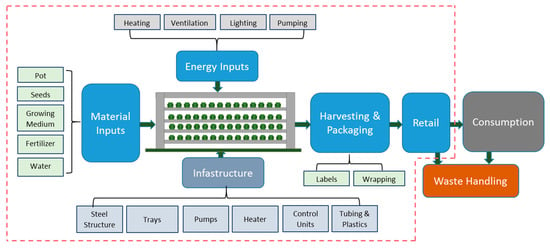
Figure 1.
System boundaries of the study (the dashed line represents the system boundaries).
The infrastructure for the vertical farming system includes LED fixtures, steel structural platforms, pumps, tubing, trays, a heater, and a control unit and timers for pumps and lighting; see Table 1 and further information on the assumptions made for the infrastructure in the Supplementary Material.

Table 1.
Material and energy inputs for the annual production of 60,000 plants.
All energy, including electricity for lighting the LED fixtures, ventilation, pumps and heating was included in the assessment. Heating of the space was assumed only to be regulated by the external heating unit (used primarily during cold months). Other heating from the local district heating system used in the building was not allocated to the assessed system as the hydroponic system produces residual heat from the LEDs. It was assumed that the ventilation systems were running 24 h per day and LED fixtures were assumed to run 12 h per day based on consultation with the producer [].
The fertilizer used for the hydroponic system was blended into the water bath and recirculated. In this study, the composition was based upon information from the producers and only the major nutrients were included: nitrogen (N), phosphorus (P) and potassium (K) (29%N, 33% P, 38%K). In addition, it was assumed that there were no fertilizer emissions to the environment due to the closed-loop system. LCI data for fertilizers was obtained from Ecoinvent v. 3.4 []; see Supplementary Material for further details.
The plants were grown in plastic pots made of polystyrene with a growing medium. Currently, gardening soil is used as the growing medium. Environmental impacts of gardening soil from the Swedish market were obtained from []. The final products were harvested, again in their original plastic pots with gardening soil, and thereafter wrapped in a waxed covered paper with labels; see depiction in Supplementary Material (Figure S1). They were then loaded into shipping trays for transportation.
Transportation of all material inputs was assumed to be 100 km for all infrastructural components and other cultivation materials. However, as the growing medium and packaging are sourced locally, the transportation distance was assumed to be 50 km (see Table 1). The transportation of the final products from the vertical farming system is primarily conducted by cargo bike, as the market is primarily local, although deliveries of the products are also conducted by car in the greater Stockholm region, assumed to be 50% of the total deliveries. The deliveries by car are assumed to be conducted by an electric vehicle as the firm owns and employs electric vehicles which can carry roughly 430 plants per delivery. Data for these inputs were provided by respective products in Ecoinvent [].
See Table 1 for a review of all input and output flows from the system and a listing of LCI data sources used in this assessment, provided in the Supplementary Material (Table S1).
2.3. Scenarios Reviewed
2.3.1. Baseline Production System
The baseline (labeled Baseline-Plastic Pot-Soil) for this study was selected to represent the current production system using gardening soil and a plastic pot for the finished product (see Table 1).
2.3.2. Scenario 2-New Packaging (Paper Pot)
The vertical farming stakeholder reviewed in this article had the intention to shift from the current plastic pot to another material, a pot made of primarily paper and peat due to pressure from customers on removing plastic packaging. A comparison was conducted to show the potential for improvements with this new pot, referred to hereafter as ‘Paper Pot’ in the scenarios (i.e., Paper Pot-Soil and Paper Pot-Coir). As the paper pots were slightly lighter than the plastic pots, only 223 kg of material was needed for them. Data for a mix of peat and paper were used to model the material inputs for the paper pot and assumed to be similar to the production of corrugated paper with data collected from Ecoinvent [].
2.3.3. Scenario 3-Growing Media
Furthermore, it is envisioned that new growing media will be used to replace the conventional use of gardening soil. For this study, the use of coir, which is a popular option for growing in hydroponic systems for the consumer market, was reviewed. For this substitution, the volume of the growing medium was used, thus reducing the total weight of the medium used requiring roughly 1 tonne less medium; see Supplementary Material for further information on assumptions used for the growing medium replacement. The scenarios including ‘-Coir’ review the use of coir in place of soil, i.e., (Plastic Pot-Coir and Paper Pot-Coir).
3. Results
Figure 2 and Table 2 provide a review of the environmental impacts for the compared scenarios. As illustrated, GHG emissions can be largely reduced by substituting plastic with paper pots and the gardening medium from gardening soil to coir. The largest reductions can be seen in the scenario employing paper pots and coir as the growing medium. The acidification impacts and abiotic resource depletion were reduced for the scenarios utilizing paper pots, (see also Figure 3 and Figure 4). However, not all impact categories followed this trend. No substantial differences in human toxicity impacts and eutrophication impacts were identified when comparing the scenarios.
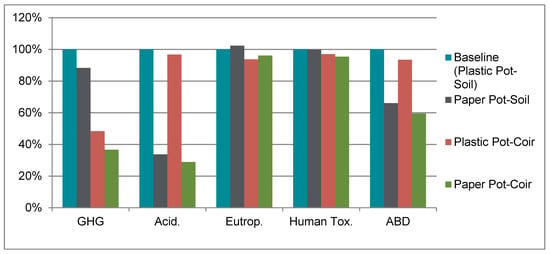
Figure 2.
Environmental impacts associated with the different scenarios, normalized to compare with impacts from the baseline scenario (Plastic Pot-Soil). Shown in percentage normalized to the baseline scenario (100%). Greenhouse gas (GHG) impacts, Acid.-Acidification Impacts, Eutrop.-Eutrophication impacts, Human Tox.-Human Toxicity Impacts, ABD-Abiotic Resource Depletion.

Table 2.
Environmental impacts associated with the different scenarios.
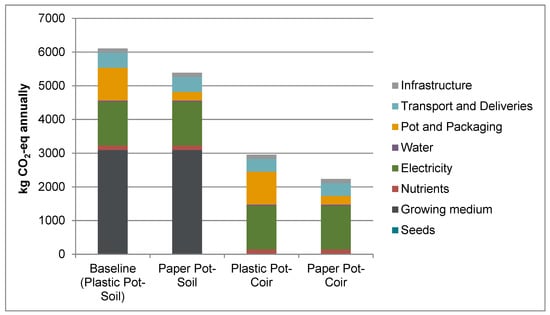
Figure 3.
Contributions of different processes to the GHG emissions annually for the different scenarios.
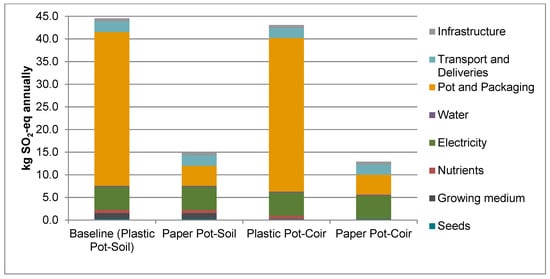
Figure 4.
Contribution of the processes to the acidification impacts annually for the different scenarios.
As illustrated in Figure 3, the growing medium, electricity, transportation and the pots employed had a significant contribution to the GHG emissions for the scenarios reviewed. The growing medium for the scenarios employing conventional soil as the growing medium contributed to the largest share of impacts. The scenarios using coir as the growing medium showed significant emissions reductions, reducing the GHG impacts by over 3000 kg CO2-eq annually. A reduction of GHG emissions by over 700 kg CO2-eq annually is also illustrated from the substitution of plastic pots for paper pots. In all scenarios, the electricity used for pumps, lighting, heating and ventilation contributed from 20% to over 50% of the GHG emissions for the different scenarios assessed. The impacts from electricity were primarily associated with the lighting systems utilized. Other processes, which did not change significantly between the scenarios, such as the seeds, infrastructure, nutrients, water, transportation and deliveries, contributed to less than 30% in all scenarios. See also further details on the GHG emissions from the different processes, material and energy inputs in the Supplementary Material (Table S2).
The acidification and abiotic resource depletion were reduced when using the paper pots in comparison to the plastic pots, as illustrated in Figure 4 and Figure 5, respectively. The major contributing processes for this reduction include extensively reduced acidification and abiotic resource depletion from the substitution of plastic for paper, in addition to replacing conventional soil with coir. For further details on the impacts and contributions from different processes and inputs from different scenarios, see the Supplementary Material (Tables S3–S6).
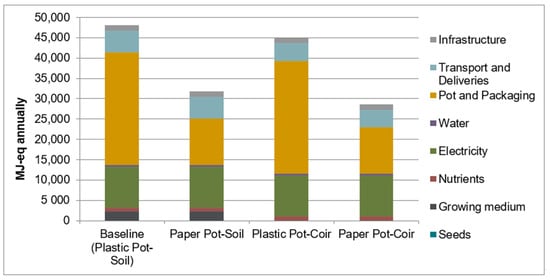
Figure 5.
Contributions of different processes to the Abiotic Resource Depletion (ABD) annually for the different scenarios.
4. Analysis and Data Sensitivity
4.1. Electricity Mix
As electricity was a major impacting process, the sensitivity to the choice of electricity mix was reviewed (see Figure 6). For this study, the Swedish electricity mix was compared with a Nordic mix, which resulted in large increases in GHG emissions. The Swedish electricity mix consists of a large share of hydropower and nuclear energy with a limited share of fossil sources, whereas the Nordic electricity mix contains a larger share of fossil fuels; see further details in LCI datasets []. For each scenario, the GHG emissions increased by nearly 2 tonnes CO2-eq annually. For the scenarios using coir, this choice nearly negated the environmental performance improvements otherwise outlined by using this growing medium.
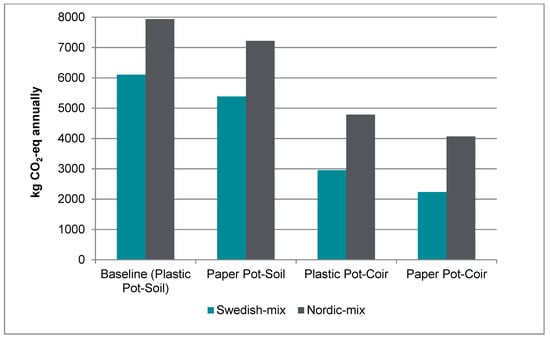
Figure 6.
Sensitivity to the choice of electricity mix.
4.2. Functional Unit Choice
Agricultural products are typically compared using various functional units. This can be related to the environmental impacts per given area, kg of product, hectare, nutritional value, etc. In the case reviewed, the plants were delivered in their pot with growing medium. An average plant weighs roughly 290 g, roughly 140 g of which is the edible portion. Although this study reviewed the impacts per annual production, the results may have been significantly influenced by the choice of functional unit when reviewing and comparing the impacts per plant with conventional production systems such as greenhouses and for similar systems, providing only the edible portion in plastic. This could include the impacts per plant per kg or per kg herbs.
As shown in Table 3, the results can vary considerably when using different functional units. When reviewing the different plant-based functional units, the results for nearly all the scenarios can vary by a factor of 7, comparing the impact per plant with that of the edible portion and stressing the requirement for transparency when comparing with other products.

Table 3.
Comparing sensitivity to GHG emissions for functional unit choice. Shown in kg CO2-eq.
4.3. Methodological Choices for Infrastructure
The infrastructure used in this assessment was illustrated to contribute only to minor impacts in all impact categories reviewed. However, it was shown to have a higher impact in [], despite shorter lifetimes for the infrastructure reviewed in this study, due to the construction of a new greenhouse in the aforementioned study. In order to show the sensitivity, the assumptions for the largest impacting inputs in the infrastructure and lifetime choices were also analyzed in the sensitivity analysis. For the sensitivity assessment, only the scenario with paper pot and soil (Paper Pot-Soil) was assessed. The sensitivity was tested by halving the lifetime assumed (Infrastructure-50% Lifetime) and by tripling the number of LEDs assumed (Infrastructure Triple LEDs). The significance of employing unused spaces was also reviewed by adding a greenhouse structure (and not using the basement area), although additional heating was not included. Impacts for a greenhouse structure were obtained from Ecoinvent v. 3.4 [], which includes a lifetime of 25 years. The size of the greenhouse was assumed to be 20 m2.
As shown in Table 4, the impacts of the infrastructure can be influenced by the methodological choices made. Decreasing the lifetime by half resulted in a doubling of the GHG emissions from the infrastructure. If the number of LEDs were assumed to triple, this would only increase the emissions of GHGs by 98%. However, if a greenhouse structure was also produced, the GHG emissions would increase by 260%. When considering the contribution of the infrastructure to the different scenarios, the best (Paper Pot-Coir) and worse (Baseline Plastic Pot-Soil) were reviewed. As illustrated in Table 4, the infrastructural choices could influence on the overall impacts. However, in the Paper Pot-Coir scenario, a more significant share of impacts can be illustrated from the infrastructural choices, especially if a greenhouse structure is added.

Table 4.
Reviewing the sensitivity to infrastructure assessments in the paper pot-soil scenario (measured in kg CO2-eq annually).
4.4. Data Choices
The gardening soil was illustrated to have the largest significance for the impacts in scenarios employing it as the growing medium, despite the modeled gardening soil based on soil produced by a more environmentally friendly producer, i.e., using less peat by employing more fiber mulch. The sensitivity to employing more conventional blends with higher shares of peat and no industrial by-products was reviewed (labeled Gardening Soil-Incr. Peat), employing data from [], as no other studies on gardening soil impacts were identified; see Figure 7.
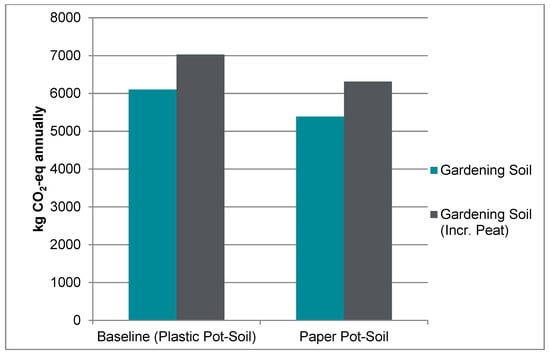
Figure 7.
Reviewing the sensitivity to the data choice for gardening soil.
As the results suggest, the GHG emissions would increase by over 1000 kg for each scenario utilizing gardening soil with more peat. This exemplifies the sensitivity for this choice, especially when comparing to the baseline to show the impact reductions from improvement options.
5. Discussion
The results from this study highlight the environmental performance of a developing vertical hydroponic farming system in Stockholm. The results suggest that electricity demands, growing medium, packaging materials and transportation have a large influence on the environmental performance of the system. In order to provide resilient, sustainable and competitive food systems, there are potential improvement options which can directly reduce the environmental impacts associated with the aforementioned processes for the vertical hydroponic farming system reviewed.
5.1. Energy
Electricity for the different processes at Grönska was found to be a major influencing input. This was primarily due to lighting, i.e., LED lighting systems employed, which accounted for the largest share of GHG emissions, although pumping for irrigation, heat and ventilation were also of substantial influence. These results concur with previous research and stipulations on the environmental (carbon footprint) of urban farming in indoor environments [,,]. Similarly, [] also found that the electricity mix employed may influence the results. This study reviewed only the use of the Swedish electricity mix compared to the Nordic electricity mix, showing significant divergence in the results obtained. However, the producer involved purchases electricity from only renewable sources, and although this was not reviewed, the impacts from such sources may have much lower environmental impacts. Thus, the results for the impacts of the electricity demand may be overestimations. This is important to highlight in the context of urban farming, as the major impact processes reviewed in this article, i.e., electricity for automation, lighting, heating, etc. are rarely exemplified in the discourse used to promote their sustainability. Also, heating for the reviewed hydroponic farming system was assumed to be only controlled by an electric heating unit. Our results for energy consumption for heating are much lower than stand-alone systems such as that reviewed in [] due to use of gas and other fuels for heating the greenhouses, showing the significant benefits of employing residual heat from buildings and connection to the district heating grid for the primary heating demand. In the future, it is also envisioned that the electricity used to operate the lighting system, i.e., LEDs, will be fully powered by solar energy. Furthermore, at Grönska a large number of diodes are used for lighting. To reduce impacts from the lighting, new compositions of diodes and changing the output and timing can further reduce electricity demand.
5.2. Growing Medium and Packaging
While previous assessments have generally not focused on the design choices for the final products but focused primarily on comparing with conventional growing systems, this study illustrates the importance of design decisions on the sustainability of the products, i.e., the growing medium and packaging materials employed. From the review of the potential implications of replacing conventional soil with coir, and plastic pots for paper-based counterparts, the results suggest that the impacts of the system can be greatly reduced across a number of environmental impact categories.
The growing media was shown to have a significant contribution to the environmental performance of the system. While this study also employed soil with less peat than conventional gardening soil based on [], a larger share of peat would substantially increase the emissions, as shown in the sensitivity analysis above. Replacing conventional soil with other media was shown to reduce the environmental impacts greatly. Similar results were stipulated by [], who suggested that using reliable industrial by-products, such as coir, bark, fiber and compost, growers can improve the sustainability of their systems. However, employing new growing media may require added infrastructure for handling automated processes (machines) employed for filling the pots and to the fertilization and irrigation requirements. This study assumed that these changes were negligible for the system based on dialogue with the producer, although this may underestimate the environmental impacts from using coir as a growing medium.
Furthermore, the hydroponic system reviewed employs the growing medium in the final product. In conventional hydroponic systems, the growing medium is reused in the growing trays, which may greatly reduce the contribution of these to the overall impacts. This is exemplified in a study by [] in which rockwool was used as the growing medium, with a non-significant impact for the life cycle of growing tomatoes. Similarly, in previous studies, the contribution of the growing medium was also very low, primarily due to it not being a part of the final product see e.g., [,]. This may also have had implications on the final waste handling for the products assessed in this study. In the Stockholm region, they may end up in municipal waste treatment (i.e., incineration), composting or biogas production, depending on choices made by the consumer in their disposal [], although this was not reviewed in this study.
The pots used for the plants were also found to be a significant impacting input for the system. By replacing plastic pots with paper pots, substantial reductions of GHG emissions, in addition to large acidification impacts and abiotic resource depletion reductions can be realized, which shows the importance for regional impacts and resource efficiency. Nonetheless, very few assessments of environmental sustainability have been attempted for reviewing different choices of planting containers and their waste handling, although consumers may prefer alternatives to plastic in order to improve the perceived sustainability []. Previous studies, such as [,], suggested that addressing materials such as the growing medium and packaging may also appeal to consumers, improving their willingness to purchase products which employ more sustainable products.
5.3. Final Product
The analysis also included a review of the impact per kg of the edible portion of the plants delivered. The results suggest that this could amount to roughly 0.27–0.74 kg CO2-eq per kg of edible plant material, depending on the growing medium and pot used. These results were slightly lower than the results for growing spinach as highlighted in [] but are comparable with findings for producing conventional lettuce from urban farming [] and hydroponic farming systems []. Thus, these findings illustrate that the vertical farming system can provide resource-efficient food production in urban environments.
However, the impacts could be further reduced by addressing design choices for the product, production system and energy demand. It may be interesting to review how the results may be influenced by the presentation of the products to the consumer. The impacts from the sold plants may be reduced further if the product is provided without the growing medium, thus avoiding a share of the impacts. Similar findings have been stipulated in more traditional greenhouses and hydroponic systems where the products did not include the growing medium but were harvested and packaged, and the growing medium was reused for plant production [,], showing low impacts for the growing medium.
Furthermore, more comparative studies will be needed for this sector. Currently, there are few assessments of the environmental impacts of vertical farming beyond carbon footprints, which is similar to suggestions by [,] for environmental assessments of traditional greenhouse farming techniques. It will be important to include these impact categories to understand the implications these systems have both globally and regionally and for comparisons to similar conventional (land-based) systems. For example, as [] suggests, vertical hydroponic farms may have considerably less impacts on water consumption and eutrophication.
5.4. Urban Context
The results of this study highlight the environmental performance of an urban farming system using vertical hydroponic systems for a niche market of herbs and leafy greens in urban contexts. As highlighted in several previous studies, urban farming has been promoted as an approach to provide more locally produced food sources, often citing the transportation of foods as a major impacting source and reason for choosing these approaches. Once again, these claims have been found by a number of authors to be unsubstantiated, see, e.g., [,,].
This study found that the transportation of materials to the system outweighs the impacts from the product deliveries, although this depends on the specific context being reviewed, and the low impacts from the regional logistics by bike and electric vehicles. As [] suggest, with shorter supply chains, this could lead to improving losses during transportation and keeping the freshness of the products. While the studied system was relatively small, expansion may require improved logistics to avoid these potential rebound effects.
Many of the products delivered by the vertical farming system (e.g., herbs and leafy greens) are also produced in Sweden by competitors using greenhouse systems. However, we have found no previous studies of these systems to compare with; thus, further research will be required for comparison to conventional systems.
This study also highlights the importance of utilizing existing space and synergies with urban systems. For example, it was found that the environmental impacts of the infrastructure are greatly reduced in this system. This is due primarily to the use of unused spaces in buildings, while previous studies have reviewed the construction of new greenhouse structures in addition to the platforms required for hydroponic farming, requiring new buildings and infrastructure; see, e.g., [,]. The sensitivity analysis further exemplifies these assertions.
In urban areas, the impacts from material inputs and energy could be further reduced through more circular approaches to take advantage of residues and urban wastes for growing media, nutrients, water requirements and energy demands and waste handling; see e.g., [,,]. Further research will also be needed to understand the potential for this type of urban symbiosis.
6. Conclusions
As urban environments explore more resilient options for food security, vertical farming methods have become increasingly popular worldwide as a solution to viably provide urban populations with sustainable food supplies. This study reviewed the environmental performance of a vertical hydroponic system in Stockholm and illustrates that it is important to address a number of processes to improve the sustainability of these systems. These include electricity demand, growing medium, location, and packaging material. The results of the scenarios suggest that design choices, such as replacing plastic pots with paper pots, can contribute to large reductions in GHG emissions, in addition to extensive reductions in acidification impacts and abiotic resource depletion. Many hydroponic systems also do not employ conventional gardening soil as the growing medium. By replacing this with fibrous by-products, such as coir, significant environmental impact reductions are possible. A large share of the impacts originates from electricity for lighting systems. Furthermore, it is important to highlight that these results are sensitive to the electricity mix employed.
In order to further reduce the impacts of the system, more resource-efficient steps will be needed to improve the impacts of electricity demand. As shown in this study, by utilizing unused spaces, i.e., synergies with the office building, the system can take advantage of residual heat from the building and reduce the impacts of added infrastructure. However, there is potential to develop more symbiotic exchanges to employ more residual energy and products in the urban environment.
Supplementary Materials
The following are available online at https://www.mdpi.com/2071-1050/11/15/4124/s1, Table S1: LCI Data employed; Table S2: GHG emissions from different scenarios (measured in kg CO2-eq emissions annually); Table S3: Acidification impacts from different scenarios (measured in kg SO2-eq emissions annually); Table S4: Eutrophication impacts from different scenarios (measured in kg PO4-eq emissions annually); Table S5: Human toxicity impacts from different scenarios (measured in kg DCB1,4-eq emissions annually); Table S6: Abiotic resource depletion from different scenarios (measured in MJ-eq annually), Figure S1: Depiction of the Grönska packaging for basil (www.gronska.se); Figure S2: Depiction of the paper pots (picture from Amazon.com).
Author Contributions
M.M. contributed to the project design, life cycle assessment, and the majority of the writing of the manuscript. E.M. contributed with a primary role in data collection and to the life cycle assessment.
Funding
This project was funded through a grant for research on developing more resource-efficient vertical hydroponic systems with Grönska Stadsodling 365 through the GrönBoStad Stockholm project, grant number 2020-1898, funded through the European Union Regional Development program.
Acknowledgments
We would like to thank Natalie, Petter and Robin at Grönska Stadsodling 365 for their support and input for this project and their determination to develop more sustainable products. Special gratitude is also owed to Sofia Poulikidou for her support in data collection and review of the databases and Johan Strandberg for allowing the project to happen. We would also like to acknowledge the support and input from the anonymous reviewers for their contribution to developing this paper.
Conflicts of Interest
The authors declare no conflict of interest.
References
- Fedoroff, N.V. Food in a future of 10 billion. Agri. Food Secur. 2015, 4, 11. [Google Scholar] [CrossRef]
- Foley, J.A.; Ramankutty, N.; Brauman, K.A.; Cassidy, E.S.; Gerber, J.S.; Johnston, M.; Mueller, N.D.; O’Connell, C.; Ray, D.K.; West, P.C.; et al. Solutions for a cultivated planet. Nature 2011, 478, 337–342. [Google Scholar] [CrossRef] [PubMed]
- Fischer, G.; Shah, M.M.; van Velthuizen, H.T. Climate Change and Agricultural Vulnerability; IIASA: Laxenburg, Austria, 2002. [Google Scholar]
- Vermeulen, S.J.; Aggarwal, P.K.; Ainslie, A.; Angelone, C.; Campbell, B.M.; Challinor, A.J.; Hansen, J.W.; Ingram, J.S.I.; Jarvis, A.; Kristjanson, P.; et al. Options for support to agriculture and food security under climate change. Environ. Sci. Pol. 2012, 15, 136–144. [Google Scholar] [CrossRef]
- Martin, M.; Brandão, M. Evaluating the Environmental Consequences of Swedish Food Consumption and Dietary Choices. Sustainability 2017, 9, 2227. [Google Scholar] [CrossRef]
- Baky, A.; Widerberg, A.; Landquist, B.; Norberg, I. Sveriges Primärproduktion och Försörjning av Livsmedel: Möjliga Konsekvenser vid en Brist på Fossil Energi; JTI: Uppsala, Sweden, 2013; Volume 2013, ISSN:14014963. [Google Scholar]
- Benke, K.; Tomkins, B. Future food-production systems: Vertical farming and controlled-environment agriculture. Sustain. Sci. Prac. Pol. 2017, 13, 13–26. [Google Scholar] [CrossRef]
- Romeo, D.; Vea, E.B.; Thomsen, M. Environmental Impacts of Urban Hydroponics in Europe: A Case Study in Lyon. Proc. CIRP 2018, 69, 540–545. [Google Scholar] [CrossRef]
- Despommier, D. The Rise of Vertical Farms. Sci. Am. 2009, 301, 80–87. [Google Scholar] [CrossRef]
- Specht, K.; Siebert, R.; Opitz, I.; Freisinger, U.; Sawicka, M.; Werner, A.; Thomaier, S.; Henckel, D.; Walk, H.; Dierich, A. Urban agriculture of the future: An overview of sustainability aspects of food production in and on buildings. Agri. Hum. Values 2014, 31, 33–51. [Google Scholar] [CrossRef]
- Kozai, T.; Niu, G. Chapter 1-Introduction. In Plant Factory; Kozai, T., Niu, G., Takagaki, M., Eds.; Academic Press: San Diego, CA, USA, 2016; pp. 3–5. [Google Scholar] [CrossRef]
- Kozai, T. Resource use efficiency of closed plant production system with artificial light: Concept, estimation and application to plant factory. Proc. Jpn. Acad. 2013, 89, 447–461. [Google Scholar] [CrossRef]
- Graamans, L.; Baeza, E.; van den Dobbelsteen, A.; Tsafaras, I.; Stanghellini, C. Plant factories versus greenhouses: Comparison of resource use efficiency. Agric. Syst. 2018, 160, 31–43. [Google Scholar] [CrossRef]
- Chance, E.; Ashton, W.; Pereira, J.; Mulrow, J.; Norberto, J.; Derrible, S.; Guilbert, S. The Plant—An experiment in urban food sustainability. Environ. Prog. Sustain. Energy 2018, 37, 82–90. [Google Scholar] [CrossRef]
- UFdeSchilde. UF De Schilde Urban Farm Approaches Completion. Available online: https://hortinext.com/uf-schilde-urban-farm-approaches-completion/ (accessed on 10 November 2018).
- AeroFarms. AeroFarms. Available online: www.aerofarms.com (accessed on 8 September 2018).
- Grönska. Grönska Stadsodling 365. Available online: http://www.gronska.se (accessed on 11 November 2018).
- UrbanOasis. Urban Oasis Homepage. Available online: www.urbanoasis.life/ (accessed on 10 June 2019).
- Eaves, J.; Eaves, S. Comparing the Profitability of a Greenhouse to a Vertical Farm in Quebec. Can. J. Agric. Econ. 2018, 66, 43–54. [Google Scholar] [CrossRef]
- Eigenbrod, C.; Gruda, N. Urban vegetable for food security in cities. A review. Agron. Sustain. Dev. 2015, 35, 483–498. [Google Scholar] [CrossRef]
- Thomaier, S.; Specht, K.; Henckel, D.; Dierich, A.; Siebert, R.; Freisinger, U.B.; Sawicka, M. Farming in and on urban buildings: Present practice and specific novelties of Zero-Acreage Farming (zfarming). Ren. Agric. Food Syst. 2014, 30, 43–54. [Google Scholar] [CrossRef]
- Kulak, M.; Graves, A.; Chatterton, J. Reducing greenhouse gas emissions with urban agriculture: A Life Cycle Assessment perspective. Land Urban Plan. 2013, 111, 68–78. [Google Scholar] [CrossRef]
- Kalantari, F.; Tahir, O.M.; Joni, R.A.; Fatemi, E. Opportunities and Challenges in Sustainability of Vertical Farming: A Review. J. Land Ecol. 2018, 11, 35. [Google Scholar] [CrossRef]
- Finnveden, G.; Hauschild, M.Z.; Ekvall, T.; Guinée, J.; Heijungs, R.; Hellweg, S.; Koehler, A.; Pennington, D.; Suh, S. Recent developments in Life Cycle Assessment. J. Environ. Manag. 2009, 91, 1–21. [Google Scholar] [CrossRef]
- Guinée, J.B.; Gorrée, M.; Heijungs, R.; Huppes, G.; Kleijn, R.; Koning, A.; de Oers, L.; van Wegener Sleeswijk, A.; Suh, S.; Udo de Haes, H.A.; et al. Handbook on Life Cycle Assessment. Operational Guide to the ISO Standards. I: LCA in Perspective. IIa: Guide. IIb: Operational Annex. III: Scientific Background; Kluwer Academic Publishers: Dordrecht, The Netherland, 2002; Volume 692, ISBN 1-4020-0228-9. [Google Scholar]
- Ecoinvent LCI Database v. 3.4; Ecoinvent: Zurich, Switzerland, 2018.
- Martin, M. Evaluating the environmental performance of producing soil and surfaces through industrial symbiosis. J. Ind. Ecol. 2019. accepted for publication. [Google Scholar]
- Shiina, T.; Hosokawa, D.; Roy, P.; Nakamura, N.; Thammawong, M.; Orikasa, T. Life Cycle Inventory Analysis of Leafy Vegetables Grown in Two Types of Plant Factories. Act. Hortic. 2011, 919, 115–122. [Google Scholar] [CrossRef]
- Barrett, G.E.; Alexander, P.D.; Robinson, J.S.; Bragg, N.C. Achieving environmentally sustainable growing media for soilless plant cultivation systems—A review. Sci. Hortic. 2016, 212, 220–234. [Google Scholar] [CrossRef]
- Dias, G.M.; Ayer, N.W.; Khosla, S.; Van Acker, R.; Young, S.B.; Whitney, S.; Hendricks, P. Life cycle perspectives on the sustainability of Ontario greenhouse tomato production: Benchmarking and improvement opportunities. J. Clean. Prod. 2017, 140, 831–839. [Google Scholar] [CrossRef]
- Avfall Sverige. Swedish Waste Management 2018; Swedish Waste Management Association: Stockholm, Sweden, 2018. [Google Scholar]
- Sanjuan-Delmás, D.; Llorach-Massana, P.; Nadal, A.; Ercilla-Montserrat, M.; Muñoz, P.; Montero, J.I.; Josa, A.; Gabarrell, X.; Rieradevall, J. Environmental assessment of an integrated rooftop greenhouse for food production in cities. J. Clean. Prod. 2018, 177, 326–337. [Google Scholar] [CrossRef]
- Nambuthiri, S.; Fulcher, A.; Koeser, A.K.; Geneve, R.; Niu, G. Moving Toward Sustainability with Alternative Containers for Greenhouse and Nursery Crop Production: A Review and Research Update. Hort. Tech. 2015, 25, 8. [Google Scholar] [CrossRef]
- Behe, B.K.; Campbell, B.L.; Hall, C.R.; Khachatryan, H.; Dennis, J.H.; Yue, C. Consumer Preferences for Local and Sustainable Plant Production Characteristics. Hort. Sci. 2013, 48, 200–208. [Google Scholar] [CrossRef]
- Khachatryan, H.; Campbell, B.; Hall, C.; Behe, B.; Yue, C.; Dennis, J. The Effects of Individual Environmental Concerns on Willingness to Pay for Sustainable Plant Attributes. Hort. Sci. 2014, 49, 69–75. [Google Scholar] [CrossRef]
- Goldstein, B.; Hauschild, M.; Fernández, J.; Birkved, M. Testing the environmental performance of urban agriculture as a food supply in northern climates. J. Clean. Prod. 2016, 135, 984–994. [Google Scholar] [CrossRef]
- Edwards-Jones, G.; Milà i Canals, L.; Hounsome, N.; Truninger, M.; Koerber, G.; Hounsome, B.; Cross, P.; York, E.H.; Hospido, A.; Plassmann, K.; et al. Testing the assertion that ‘local food is best’: the challenges of an evidence-based approach. Trends Food Sci. Technol. 2008, 19, 265–274. [Google Scholar] [CrossRef]
- Edwards-Jones, G. Does eating local food reduce the environmental impact of food production and enhance consumer health? Proc. Nutr. Soc. 2010, 69, 582–591. [Google Scholar] [CrossRef]
- Coley, D.; Howard, M.; Winter, M. Local food, food miles and carbon emissions: A comparison of farm shop and mass distribution approaches. Food Pol. 2009, 34, 150–155. [Google Scholar] [CrossRef]
- Gentry, M. Local heat, local food: Integrating vertical hydroponic farming with district heating in Sweden. Energy 2019, 174, 191–197. [Google Scholar] [CrossRef]
© 2019 by the authors. Licensee MDPI, Basel, Switzerland. This article is an open access article distributed under the terms and conditions of the Creative Commons Attribution (CC BY) license (http://creativecommons.org/licenses/by/4.0/).